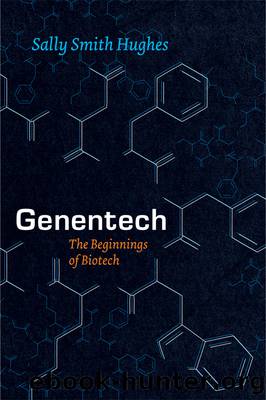Genentech by Sally Smith Hughes;

Author:Sally Smith Hughes;
Language: eng
Format: epub
Publisher: University of Chicago Press
Published: 2011-06-15T00:00:00+00:00
The scientists then proposed a highly original concept: they would attempt to build a semi-synthetic gene coding for growth hormone, using DNA synthesis and complementary DNA methods. Asked in litigation two decades later who came up with the strategy, Seeburg replied, âOh . . . this is difficult to say. I donât think I can name one particular person that had this idea.â16 The patent application of July 5, 1979, nonetheless named Goeddel and Heyneker as inventors. The City of Hope chemists were to construct a short segment for the front of the artificial gene, including the bacterial signal system controlling gene expression. Seeburg was to make a long complementary DNA segment coding for most of the human growth hormone protein. The plan was to clone the synthetic and complementary DNA pieces in separate procedures and then join the two to form a hybrid gene. Making a functional semi-synthetic gene was a tall order; it had never been done before and would require a new level of technical sophistication. Two days after the meeting, Swanson sent Seeburg, and presumably also John Shine, checks for their consulting services.17 Seeburg and Shine, along with Howard Goodman, were also consulting on growth hormone for Eli Lilly, just as Rutter, Goodman, and Ullrich were consultants for Lilly on insulin. The UCSF biochemists had clearly grasped the applied potential of their research and appeared willing to take on conflicting alliances.
A strategy in place, Itakuraâs lab immediately began the tedious work of synthesizing the DNA coding for the first 24 amino acids. That accomplished, the research devolved to the Genentech molecular biologists. Goeddel and Heyneker linked the synthetic DNA fragments for the front of the gene and began to construct a plasmid to express the hybrid gene. Everyone expected Seeburg, with his arrival at Genentech in November, to start immediately constructing the complementary DNA component. Instead, the project rapidly unraveled. What happened next speaks to the raw intensity and extraordinary competitiveness of recombinant DNA research of the late 1970s.
A letter may have inadvertently set the ball rolling. In November 1978 Swanson and Kleid wrote to Goodman, requesting the transfer of Seeburgâs biological materials to Genentech. They specifically requested the precious human growth hormone complementary DNA that Seeburg had made at UCSF.18 Goodman flatly refused. Three months later, tension rising, Goodman and John Baxter warned Seeburg that any research materials removed without the universityâs authorization and used in experiments violated UC policy and the NIH guidelines.19 The impetus for the letter was very likely an extraordinary event, extraordinary even in a decade of extraordinary events in the formerly staid field of molecular biology.
The incident or âmidnight raid,â as Ullrich referred to it, occurred on New Yearâs Eve 1978 as he made final preparations to go to Genentech. Seeburg, whom Goodman had banned from the premises after a furious dispute in November over his ties to Genentech, asked to accompany Ullrich to remove some biological samples and take them to the company across the bay.20 Ullrich agreed, being
Download
This site does not store any files on its server. We only index and link to content provided by other sites. Please contact the content providers to delete copyright contents if any and email us, we'll remove relevant links or contents immediately.
| Anatomy | Animals |
| Bacteriology | Biochemistry |
| Bioelectricity | Bioinformatics |
| Biology | Biophysics |
| Biotechnology | Botany |
| Ecology | Genetics |
| Paleontology | Plants |
| Taxonomic Classification | Zoology |
Sapiens: A Brief History of Humankind by Yuval Noah Harari(13986)
The Tidewater Tales by John Barth(12391)
Mastermind: How to Think Like Sherlock Holmes by Maria Konnikova(6936)
Do No Harm Stories of Life, Death and Brain Surgery by Henry Marsh(6683)
The Thirst by Nesbo Jo(6435)
Why We Sleep: Unlocking the Power of Sleep and Dreams by Matthew Walker(6352)
Life 3.0: Being Human in the Age of Artificial Intelligence by Tegmark Max(5184)
Sapiens by Yuval Noah Harari(5121)
The Longevity Diet by Valter Longo(4856)
The Body: A Guide for Occupants by Bill Bryson(4580)
The Rules Do Not Apply by Ariel Levy(4523)
The Immortal Life of Henrietta Lacks by Rebecca Skloot(4253)
Why We Sleep by Matthew Walker(4190)
Animal Frequency by Melissa Alvarez(4148)
Yoga Anatomy by Kaminoff Leslie(4100)
The Hacking of the American Mind by Robert H. Lustig(4082)
All Creatures Great and Small by James Herriot(3984)
Barron's AP Biology by Goldberg M.S. Deborah T(3943)
Double Down (Diary of a Wimpy Kid Book 11) by Jeff Kinney(3924)
